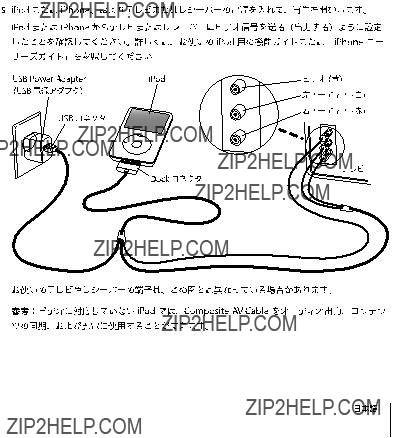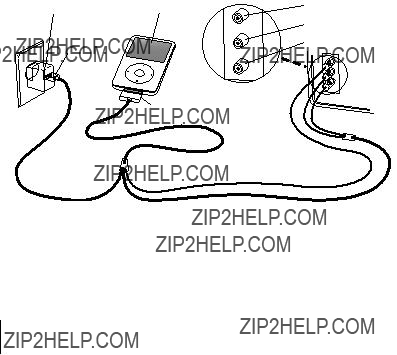
Apple Composite
AV Cable

Apple Composite
AV Cable

1 Composite AV Cable
Use the Composite AV Cable to connect your iPod or iPhone to the composite video and analog audio ports on your TV, home theater receiver, or stereo receiver. The Composite AV Cable features a USB connector that you can plug into a power source, such as a computer or the included USB Power Adapter.
Before you begin connecting components, turn down the volume on iPod or iPhone and turn off the power to all your components. Remember to make all connections firmly to avoid humming and noise.
Important: Never force a connector into a port. If the connector and port don???t join with reasonable ease, they probably don???t match. Make sure that the connector matches the port and that you have positioned the connector correctly in relation to the port.
To use the Composite AV Cable to connect iPod or iPhone to your TV or receiver:
1 Plug the yellow video connector into the video input port on your TV or receiver.
2Plug the white and red audio connectors into the left and right analog audio input ports, respectively, on your TV or receiver.
3 Plug the iPod Dock Connector into your iPod, iPhone, or Universal Dock.
4Plug the USB connector into your USB Power Adapter or your computer to keep your iPod or iPhone charged.
2English

5Turn on iPod or iPhone and your TV or receiver to start playing.
Make sure you set your iPod or iPhone to send a video signal out to your TV or receiver.
For more information, see the user guide for your iPod or iPhone.
USB connector
Television
Dock Connector
The ports on your TV or receiver may differ from the ports in the illustration.
Note: If your iPod doesn???t support video, you can use the Composite AV Cable for audio output, syncing content, and charging.
English 3

2
4

5

3 C??ble composite AV
Le c??ble composite AV permet de brancher votre iPod ou iPhone aux ports composite vid??o et audio analogique de votre t??l??viseur, de votre r??cepteur home cin??ma ou encore de votre r??cepteur st??r??o. Ce c??ble est dot?? d???un connecteur USB ?? brancher sur une source d???alimentation ??lectrique, par exemple un ordinateur ou l???adaptateur secteur USB inclus.
Avant de brancher des composants, baissez le volume de l???iPod ou iPhone et ??teignez tous vos composants.
Important : ne forcez jamais en enfon??ant un connecteur dans un port. S???ils ne s???accouplent pas facilement, il est probable qu???ils ne soient pas faits pour ??tre branch??s ensemble.
Pour utiliser le c??ble composite AV pour brancher l???iPod ou iPhone ?? votre t??l??viseur ou votre r??cepteur :
1Branchez la prise vid??o jaune sur le port d???entr??e vid??o de votre t??l??viseur ou de votre r??cepteur.
2Connectez les prises audio blanche et rouge sur les ports d???entr??e audio analogique respectifs gauche et droit de votre t??l??viseur ou de votre r??cepteur.
3 Branchez le connecteur Dock sur votre iPod, iPhone ou votre socle universel.
6Fran??ais

4Connectez la prise USB ?? votre adaptateur secteur USB ou ?? votre ordinateur pour que votre iPod ou iPhone ne se d??charge pas.
5Allumez l???iPod ou iPhone et votre t??l??viseur ou votre r??cepteur pour lancer la lecture.
Connecteur USB
T??l??vision
Connecteur Dock
Il se peut que les ports de votre t??l??viseur ou votre r??cepteur diff??rent de ceux illustr??s ici.
Remarque : si votre iPod ne prend pas en charge la vid??o, vous pouvez n??anmoins vous servir du c??ble composite AV pour assurer la sortie audio, la synchronisation des donn??es et la recharge de la batterie.
Fran??ais 7

4 Composite
Verwenden Sie das Composite
Vor dem Anschlie??en von Komponenten sollten Sie die Lautst??rke Ihres iPod bzw. iPhone reduzieren und alle Komponenten ausschalten. Achten Sie darauf, alle Kabel korrekt anzuschlie??en, um st??rende Ger??usche zu vermeiden.
Wichtig: Versuchen Sie niemals, einen Stecker gewaltsam mit dem Anschluss zu ver- binden. L??sst sich der Stecker nicht problemlos mit dem Anschluss verbinden, passen Stecker und Anschluss vermutlich nicht zueinander. Vergewissern Sie sich, dass der Stecker zum Anschluss passt und dass Sie den Stecker korrekt mit dem Anschluss ausgerichtet haben.
8Deutsch

Gehen Sie wie folgt vor, um den iPod oder das iPhone mithilfe des Composite AV- Kabels an Ihr Fernsehger??t oder Ihren Empf??nger anzuschlie??en:
1Schlie??en Sie den gelben Videostecker an den Videoeingang Ihres Fernsehger??ts oder
Empf??ngers an.
2Schlie??en Sie den wei??en und den roten Audiostecker an die linken und rechten analogen Audioeing??nge Ihres Fernsehger??ts oder Empf??ngers an.
3 Schlie??en Sie den iPod
4Verbinden Sie den
5Schalten Sie den iPod bzw. das iPhone und das Fernsehger??t bzw. den Empf??nger ein, um die Wiedergabe zu starten.
Deutsch 9

Vergewissern Sie sich, dass Sie Ihren iPod bzw. Ihr iPhone zum Senden eines Videosignals an Ihr Fernsehger??t bzw. Ihren Empf??nger konfiguriert haben. Weitere Informationen hierzu finden Sie im Funktionshandbuch zu Ihrem iPod oder iPhone.
Fernsehger??t
M??glicherweise sehen die Anschl??sse an Ihrem Fernsehger??t oder Empf??nger anders als hier dargestellt aus.
Hinweis: Wenn Ihr iPod keine Videounterst??tzung bietet, k??nnen Sie das Composite
10 Deutsch

Cable de AV compuesto
Utilice el cable de AV compuesto para conectar el iPod o iPhone a los puertos de audio anal??gico y v??deo compuesto de su televisor, receptor de cine en casa o equipo est??reo. El cable de AV compuesto incorpora un conector USB que puede conectarse a una fuente de alimentaci??n, como un ordenador o el adaptador de corriente USB incluido.
Antes de empezar a conectar componentes, desactive el sonido del iPod o iPhone y desconecte de la corriente todos los componentes. Recuerde acoplar bien todas las conexiones para evitar o??r zumbidos y ruidos.
Importante: Nunca introduzca un conector en un puerto por la fuerza. Si el conector y el puerto no encajan con una facilidad razonable, probablemente es que no est??n hechos el uno para el otro. Aseg??rese de que el conector encaja con el puerto y de que lo ha colocado en la posici??n correcta.
Para utilizar el cable de AV compuesto para conectar el iPod o iPhone al televisor o a un receptor:
1Enchufe el conector de v??deo amarillo al puerto de entrada de v??deo de su televisor o receptor.
2Enchufe los conectores blanco y rojo en los puertos de entrada de audio anal??gico izquierdo y derecho, respectivamente, del televisor o receptor.
3 Enchufe el conector iPod Dock Connector al iPod, iPhone o a la base Universal Dock.
Espa??ol 11

4Enchufe el conector USB en el adaptador de corriente USB o en el ordenador para que el iPod o iPhone no se descargue.
5Encienda el iPod o iPhone y el televisor o receptor para iniciar la reproducci??n.
Aseg??rese de configurar el iPod o iPhone para enviar se??al de v??deo al televisor o receptor. Para m??s informaci??n, consulte la gu??a de caracter??sticas de su iPod o iPhone.
Los puertos del televisor o receptor pueden diferir de los puertos de la ilustraci??n.
Nota: Si su iPod no permite visualizar v??deos, puede utilizar el cable de AV compuesto para reproducir audio, sincronizar contenidos y cargar el iPod.
12 Espa??ol

Cavo AV composito
Utilizza il cavo AV composito per collegare iPod o iPhone alle porte video composito e audio analogico della TV o del ricevitore dell???home theater o dello stereo. Il cavo AV
composito ?? dotato di un connettore USB che puoi collegare a una fonte di alimentazione, come un computer o l???adattatore di corrente USB incluso.
Prima di collegare i componenti, abbassa al minimo il volume di iPod o iPhone ed elimina l???alimentazione da tutti i componenti. Ricordati di assicurarti che tutti i collegamenti siano saldi, per evitare ronzio e altro rumore.
Importante: non forzare mai un connettore in una porta. Se il connettore non entra con facilit?? nella porta, probabilmente non sono compatibili. Assicurati che lo spinotto del connettore sia adatto alla porta e che il connettore sia posizionato correttamente in relazione alla porta.
Per utilizzare il cavo AV composito per collegare iPod o iPhone alla TV o al ricevitore:
1 Collega il connettore video giallo alla porta di ingresso video della TV o del ricevitore.
2Collega i connettori audio (bianco e rosso) alle porte di sinistra e di destra di ingresso audio analogico, rispettivamente, della TV o del ricevitore.
3 Collega iPod Dock Connector a iPod, iPhone o al Dock universale.
4Collega il connettore USB all???alimentatore di corrente USB o al computer per mantenere carichi iPod o iPhone.
Italiano 13

5Accendi iPod o iPhone e la TV o il ricevitore per avviare la riproduzione.
Assicurati di aver impostato iPod o iPhone per inviare un segnale video in uscita alla
TV o al ricevitore. Per ulteriori informazioni, consulta la guida alle funzionalit?? di iPod o il Manuale Utente di iPhone.
Le porte della TV o del ricevitore potrebbero essere diverse da quelle dell???illustrazione.
Nota: se iPod non supporta i video, puoi utilizzare il cavo AV composito per l???uscita audio, per sincronizzare contenuti e per caricare il dispositivo.
14 Italiano

Regulatory Compliance Information
Compliance Statement
This device complies with part 15 of the FCC rules. Operation is subject to the following two conditions: (1) This device may not cause harmful interference, and (2) this device must accept any interference received, including interference that may cause undesired operation. See instructions if interference to radio or television reception is suspected.
L???utilisation de ce dispositif est autoris??e seulement aux conditions suivantes: (1) il ne doit pas produire de brouillage et (2) l???utilisateur du dispositif doit ??tre pr??t ?? accepter tout brouillage radio??lectrique re??u, m??me si ce brouillage est susceptible de compromettre le fonctionnement du dispositif.
Radio and Television Interference
The equipment described in this manual generates, uses, and can radiate
This equipment has been tested and found to comply with the limits for a Class B digital device in accordance with the specifications in Part 15 of FCC rules. These specifications are designed to provide reasonable protection against such interference in a residential installation. However, there is no guarantee that interference will not occur in a particular installation.
You can determine whether your computer system is causing interference by turning it off. If the interference stops, it was probably caused by the computer or one of the peripheral devices.
If your computer system does cause interference to radio or television reception, try to correct the interference by using one or more of the following measures:
??Turn the television or radio antenna until the interference stops.
??Move the computer to one side or the other of the television or radio.
??Move the computer farther away from the television or radio.
??Plug the computer into an outlet that is on a different circuit from the television or radio. (That is, make certain the computer and the television or radio are on circuits controlled by different circuit breakers or fuses.)
If necessary, consult an Apple Authorized Service Provider or Apple. See the service and support information that came with your Apple product. Or, consult an experienced radio or television technician for additional suggestions.
15

Important: Changes or modifications to this product not authorized by Apple Inc. could void the FCC compliance and negate your authority to operate the product. This product was tested for FCC compliance under conditions that included the use of Apple peripheral devices and Apple shielded cables and connectors between system components. It is important that you use Apple peripheral devices and shielded cables and connectors between system components to reduce the possibility of causing interference to radios, television sets, and other electronic devices. You can obtain Apple peripheral devices and the proper shielded cables and connectors through an
Responsible party (contact for FCC matters only):
Apple Inc. Corporate Compliance
1 Infinite Loop M/S
Cupertino, CA
European Compliance Statement
This product complies with the requirements of European Directives 72/23/EEC, 89/336/EEC, and 1999/5/EC.
Korea Statements
Taiwan Class B Statement
Industry Canada Statements
Complies with the Canadian
This Class B device meets all requirements of the Canadian
Cet appareil num??rique de la Class B respecte toutes les exigences du R??glement sur le mat??riel brouilleur du Canada.
Disposal and Recycling Information
When this product reaches its end of life, please dispose of it according to your local environmental laws and guidelines.
For information about Apple???s recycling programs, visit: www.apple.com/environment/recycling
16

Apple and the Environment
Apple Inc. recognizes its responsibility to minimize the environmental impacts of its operations and products. More information is available on the web at: www.apple.com/environment
European
The symbol above means that according to local laws and regulations your product should be disposed of separately from household waste. When this product reaches its end of life, take it to a collection point designated by local authorities. Some collection points accept products for free. The separate collection and recycling of your product at the time of disposal will help conserve natural resources and ensure that it is recycled in a manner that protects human health and the environment.
Union
Le symbole
17

Europ??ische
Das Symbol oben bedeutet, dass dieses Produkt entsprechend den geltenden gesetzlichen Vorschriften und getrennt vom Hausm??ll entsorgt werden muss. Geben Sie dieses Produkt zur Entsorgung bei einer offiziellen Sammelstelle ab. Bei einigen Sammelstellen k??nnen Produkte zur Entsorgung unentgeltlich abgegeben werden. Durch das separate Sammeln und Recycling werden die nat??rlichen Ressourcen geschont und es ist sichergestellt, dass beim Recycling des Produkts alle Bestimmungen zum Schutz von Gesundheit und Umwelt beachtet werden.
Unione
Questo simbolo significa che, in base alle leggi e alle norme locali, il prodotto dovrebbe essere eliminato separatamente dai rifiuti casalinghi. Quando il prodotto diventa inutilizzabile, portarlo nel punto di raccolta stabilito dalle autorit?? locali. Alcuni punti di raccolta accettano i prodotti gratuitamente. La raccolta separata e il riciclaggio del prodotto al momento dell???eliminazione aiutano a conservare le risorse naturali e assicurano che venga riciclato in maniera tale da salvaguardare la salute umana e l???ambiente.
Europeiska
Symbolen ovan betyder att produkten enligt lokala lagar och best??mmelser inte f??r kastas tillsammans med hush??llsavfallet. N??r produkten har tj??nat ut m??ste den tas till en ??tervinningsstation som utsetts av lokala myndigheter. Vissa ??tervinningsstationer tar kostnadsfritt hand om uttj??nta produkter. Genom att l??ta den uttj??nta produkten tas om hand f??r ??tervinning hj??lper du till att spara naturresurser och skydda h??lsa och milj??.
?? 2008 Apple Inc. All rights reserved.
Apple, the Apple logo, and iPod are trademarks of Apple Inc., registered in the U.S. and other countries. iPhone is a trademark of Apple Inc.
18
www.apple.com
Printed in XXXX